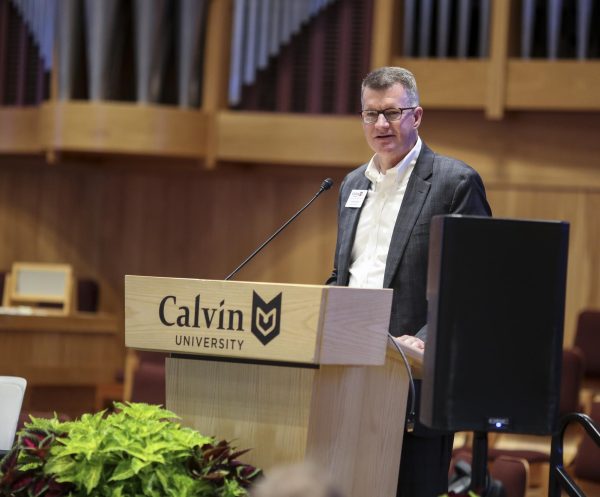“Complex,” “murky” and “nuanced”: Understanding Prop 3
Advocates of Prop 3 have promoted it as a way to reinstate Roe in the wake of the U.S. Supreme Court’s ruling in June, which overturned the constitutional right to abortion.
Proposition 3 on Michigan’s midterm ballot this week is an amendment to the state constitution that, if passed, would legalize abortion in the state. The issue of abortion has been controversial for decades; this proposition is no different — the wording of the proposition, the political method by which proponents are trying to legislate and the morality of abortion itself are all contentious issues.
The initiative to put the proposal on the midterm ballot began in the spring and received more than 735,000 voter signatures, making it one of the most widely supported Michigan ballot initiatives in recent history.
“It’s had a big impact just inside of Michigan, [but] it’s also, the nation is watching,” political science professor Micah Watson told Chimes. According to Watson, wealthy, well-known figures all over the country have donated to the push for abortion legislation; over $57 million has been given in total, with more than two-thirds of that donated in support of the proposition. Advocates of Prop 3 have promoted it as a way to reinstate Roe in the wake of the U.S. Supreme Court’s Dobbs v. Jackson Women’s Heath Organization ruling in June, which overturned the constitutional right to abortion.
“Pollings show that the majority of Americans liked Roe, or thought they liked Roe,” Watson said. The popularity of Roe has helped Prop 3 garner support, according to Watson. Proposition 3 provides the same level of protection for abortion that Roe did, and might even exceed it, according to Watson.
History
In 1973, the Supreme court in Roe v. Wade established a constitutional right to abortion, effectively legalizing abortion across the country. The Casey ruling of 1992 upheld the right to abortion, but it also allowed states to implement more restrictions, said Watson.
These restrictions included different gestational ages at which an elective abortion (the termination of an otherwise healthy pregnancy) procedure could be performed, which varied by state, according to Russ Jelsma, a high-risk pregnancy physician and Calvin alumnus, who is now the senior medical director of Women’s Health at Natura, told Chimes.
“I think now it is more of a fear of interpreting … What’s viability?
In Michigan, this age was 24 weeks. In some states, obstetrician/gynecologists could perform elective abortions up until the moment of birth, while other states were more restrictive than Michigan. Despite this variation, Jelsma said standards for physicians were clear and, under Roe, the country had established a functional system. “[Different states] had different cutoffs, but it was very clear in the physician’s mind,” Jelsma said, “We were in … a working medium for pregnant mothers around the country.”
Issues of interpretation
The proposed amendment has five sections. The crux of the controversy is the third paragraph of the first section, which — as summarized on the ballot — would “allow state to regulate abortion after fetal viability but not prohibit if medically needed to protect a patient’s life or physical or mental health.” This phrasing raises concerns for Jelsma around the language of fetal viability.
“I think now it is more of a fear of interpreting … What’s viability?” Jelsma said. “The gestational age for survival keeps going down, and so that’s why the viability thing is … I would say, nebulous.”
Previously, a patient could have an elective abortion at 24 weeks but couldn’t have any abortion after 24 weeks, except to preserve the life of the mother. Since the overturning of Roe, the regulations around abortion have been less clear.
Lawmakers are writing these rules, Jelsma said, but physicians are the ones who need to interpret them. Jelsma said he worries that if policy on the issue remains “murky” physicians could be put in difficult situtations.
The fact that this proposal allows abortion after fetal viability for mental health reasons is also debated, due to the lack of definition regarding mental health. “That exception is such a big loophole you could drive a truck through it,” said Watson.
“From my understanding of how [the amendment] is written, I think it is broad, and I think it needs to be broad.
It is a positive thing that society is becoming more aware of the significance of mental health because “mental pain is real pain,” Elisha Marr, Calvin sociologist and professor, told Chimes.
“Anyone who is diagnosed with anxiety has a mental illness and that’s a lot of people,” Marr said. “[But] where are we going to draw that line? We’re paying attention now, but we have no standards [of] … how we’re gonna measure it or what’s going to be the benchmark.”
However, a legal benchmark may not be the best solution, according to Julie Yonker, psychology professor. “From my understanding of how [the amendment] is written, I think it is broad, and I think it needs to be broad,” she said. Individual patients, their doctors, and their support system can best understand how either having or not having an abortion might affect the individual’s short-term and long-term mental health, according to Yonker.
If Prop 3 is approved, “more power is given to individuals and physicians and nurse practitioners … to make decisions, and less for legislators and judges and policymakers,” Marr said.
Morality, legality and practicality
Prop 3 is the current epicenter, in Michigan, of the abortion issue, which philosophy professor Kevin Timpe said is a moral one as well as a legal one.
“Clearly a central question is whether or not abortion is ever morally permissible, but that is a very complicated and controversial question,” Timpe said, in part because the answer depends on how one defines personhood. According to Timpe, ways of defining personhood have varied across history, even within the Christian tradition.
“One of the things we should be thinking about is what could we do such that [abortion] isn’t the primary question that comes up for folks.
But aside from the questions of personhood and morality, Timpe said there are other ethical questions as well; Lack of resources, poor maternal care, poverty and ableism are ethically charged issues, and they all relate to the issue of abortion.
Timpe told Chimes, “I think that often we want to simplify many of those [questions] down to just the first one, about the moral status of a particular act, but we need to think about how we approach that question in a much broader context.”
While morality and legality are frequently equated in the abortion debate, Timpe said they shouldn’t necessarily be; “There are many things we think are morally wrong but aren’t illegal, so even if we agreed on the moral issues the implications for the legal issues isn’t obvious.”
Watson takes into account a broad political context when thinking about the legality of abortion, rather than the morality of it. Most European countries ban abortion beginning after 15 weeks, and so “under Roe most European countries’ abortion laws would be unconstitutional,” he said.
He also highlighted the significance of the fact that Proposition 3 is a state constitutional amendment; Watson told Chimes, “there’s a certain weight to this should it pass … that’s on a different level than if it was just a debate about what the legislature should pass.” In order to change Proposition 3, the state constitution would have to be amended once again, whereas if it were a legislative act, it could simply be overturned by other legislation.
“We know the one thing — sociologically — that decreases abortion is increased access to birth control. It just is.
In part because of the constitutional status of this proposition, the mental health loophole, and the political climate in the state of Michigan, Watson said, “If there was a constitutional proposal that is 100% pro-life it would be unrealistic and would be politically extreme … and I think that this is the pro-choice version of that.”
Therefore, Watson proposes an alternative, arguing for “a procedural case that lets the legislature and the governor hammer out a compromise that better fits where most Michiganders are at.”
In the meantime, if fewer numbers of abortions is the goal, Marr has a solution. “We know the one thing — sociologically — that decreases abortion is increased access to birth control. It just is,” she said.
Yonker agreed, and added that more of a focus on providing better sex education also helps; “Studies have shown it does not increase sexual activity; it just makes things safer,” said Yonker.
Voting
The issue of abortion is “complex,” “murky” and “nuanced,” according to Timpe, Jelsema and Yonker, respectively. It’s also “contentious”, according to Watson, because there are goods on each side.
When thinking about how to vote wisely, Watson said, “I want to weigh the different goods that are … at stake and think about those goods, and then think about the proposed means to either achieve or protect those goods.”
Timpe takes a slightly different approach; “One of the things we should be thinking about is what could we do such that [abortion] isn’t the primary question that comes up for folks,” he said. Like Yonker and Marr, he said improving circumstances on related issues, such as better health care, social policy and contraception could be good legislative tools to reduce abortions.
But no matter what side you fall on in this debate, Watson said it is important, “to try and counter and evaluate and give a hearing to people who think differently than you.”








